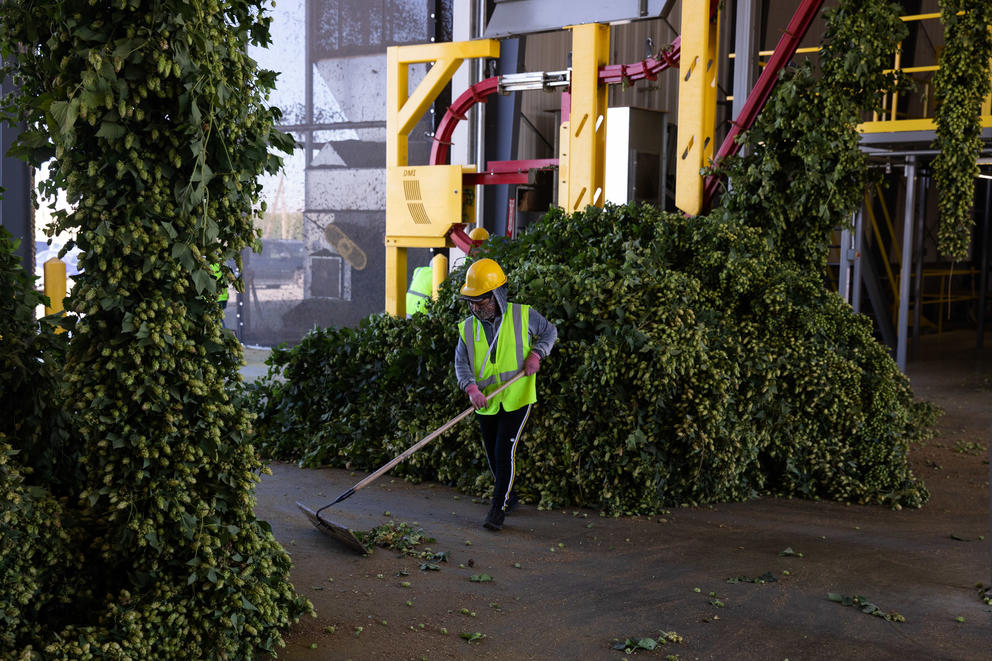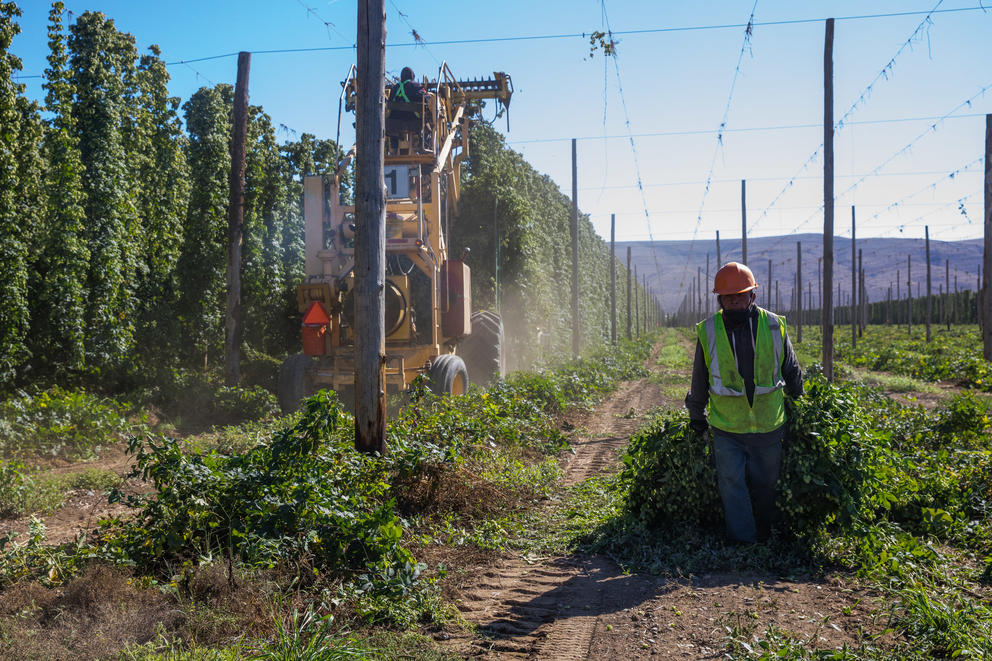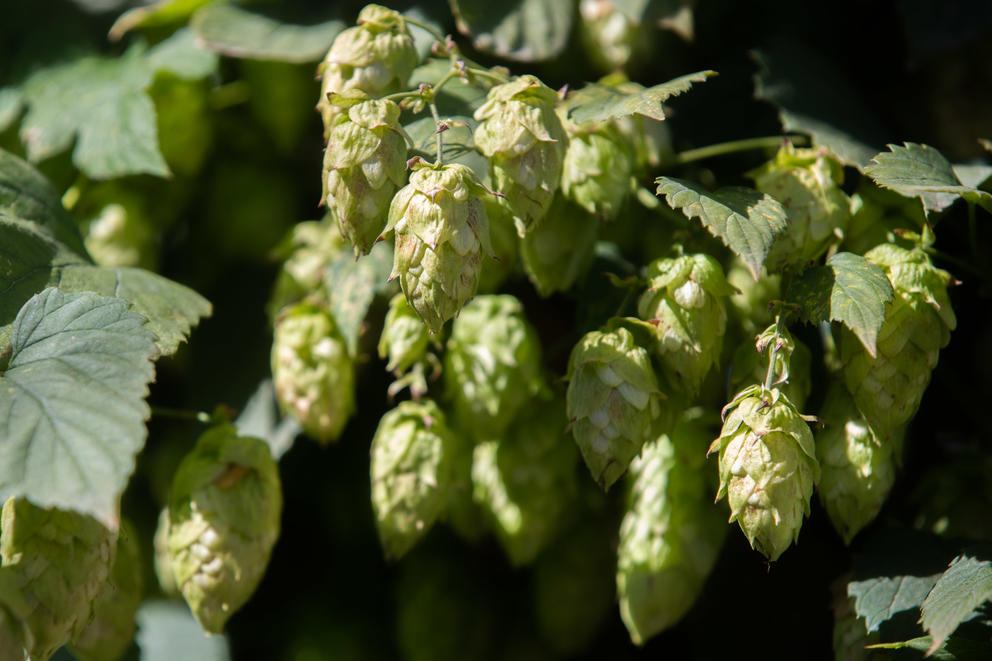But dried hops come with a high environmental price. Drying hops makes up 47% of the carbon footprint of hop production and processing, according to a recently completed life cycle assessment from the Hop Growers of America, a Yakima-based trade organization.
This information gives the U.S. hop industry, which is concentrated in the Pacific Northwest, an easy target to tackle its contributions to climate change and enable its brewery customers around the world to do the same.
“Most people in the industry recognize the kilning process [would be] a substantial portion of our greenhouse gasses,” said Maggie Elliot, science and communications director of the Hop Growers of America. “But almost half — 47% — I think it was a staggering number for the industry.”
A life cycle assessment is a method to measure and compare environmental impacts during a commercial product’s lifetime. For the Hop Growers of America, the assessment is a first step in developing a comprehensive strategy to reduce the industry’s carbon footprint and make its production processes more environmentally sustainable.
The assessment provides hop growers and processors with baseline energy, chemical, water and land usage metrics, which are gathered during the commercial whole hop production. The report also looks at energy and water usage when processing whole hops into pellets, which is done for several months following harvest.
This assessment aims to provide a baseline of metrics to help those in the industry, including growers, processors and those who sell hops to breweries, take action, Elliot said.
Such information also is helpful for craft breweries across the U.S. seeking to understand their beer production’s environmental impact. Having data about the carbon footprint of raw materials used to brew beer, such as hops, can provide breweries with a more accurate evaluation of their impact.
The assessment, paid for by industry donors, is based on data collected by several hop growers and processors in Washington, Oregon and Idaho, which collectively grew nearly all of the U.S. crop throughout the 2021 hop production and processing season.
Out of the 115.6 million pounds of hops harvested last fall, 73% came from Washington state (about 84.6 million pounds), primarily from the Yakima Valley in Central Washington, according to a U.S. Department of Agriculture report from late last year. Nearly the rest of the U.S. hop crop — 26.8% — came from Oregon and Idaho, which harvested 12.6 million and 18.4 million pounds, respectively.
Drying and greenhouse gas emissions
The greenhouse gas emissions from the growing and drying of one kilogram — a little over 2.2 pounds — of dry whole hops generate the equivalent of 3.1 kilograms to 3.7 kilograms of carbon dioxide. Increased carbon dioxide in the atmosphere is a primary contributor to climate change because of the gas’ ability to trap heat, which increases the Earth’s temperature.
Processing those hops into pellets generates 0.32 kilograms of carbon dioxide for each kilogram of pellets, putting the total carbon footprint at 3.5 kilograms to 4.1 kilograms of carbon dioxide.
Nearly three-quarters of emissions are from energy use during the growing of hops, including electricity used during harvests and fuel for tractors and other equipment. About 64% of emissions during processing is from processing hops.
The drying of hops makes up 72% of emissions from energy consumption during the hop growth and processing process. That means out of all emissions from hop growing, harvesting and processing, 47% of it comes from the drying process.
After hops are harvested, they are spread in a flat layer inside of a kiln, which is heated by propane. Heat is blasted below the layer of hops to dry them, which takes several hours.
The dried hops are then packaged and transported to warehouses that store hops whole or to processing facilities, where they are turned into value-added products, such as pellets and oils.
For Jeff Perrault of Perrault Farms, a Toppenish-based farm that provided data for the life cycle assessment, the high emissions from drying were not a surprise.
The assessment’s findings affirmed his ongoing efforts to invest more in purchasing new drying systems that adjust the level of fan pressure, which directs heat to the hops in the propane-powered kiln. Fresh hops start heavier because of their high water content. But as they’re dried, their decreased weight prompts the system to lower fan pressure, which reduces propane use.
Perrault also recently implemented a method to measure propane usage throughout the farm, especially in the drying process. That will be key as his company measures improvements by implementing new techniques and technologies, such as installing baffle systems to help growers better control heat flow during drying and, ideally, improve fuel usage efficiency.
With fuel prices rising in recent months, there’s also a financial incentive to reduce energy usage.
“By creating efficiencies in the [drying] process, it’s not only good for the environment, but you’re buying less fuel, which benefits both the business and [brewery] consumers,” Perrault said.
How that IPA contributes to climate change
Another notable finding in the assessment is that aroma hops had a slightly larger carbon footprint than alpha hops, which are commonly used as a bittering agent in beer brewing.
Aroma hops are often used in flavor-forward beers, such as IPAs, a beloved brew among beer enthusiasts that has exploded in popularity in recent years.
But it turns out that the aroma hops in those popular IPAs may have a bigger climate impact. That’s because aroma hops require more water and space to grow than other hop varieties.
And with the explosion of craft breweries producing these hop-forward beers — growers have increased the production of aroma hop varieties significantly in the past decade.
For example, Citra, a proprietary aroma hop variety released by Yakima-based Hop Breeding Co. has grown exponentially since its debut in 2007, with breweries loving the citrus and tropical flavor it produced. In 2009, 81,900 pounds of Citra were harvested in Washington state. Last fall, Washington growers grew nearly 13.9 million pounds of the variety.
To produce one kilogram of aroma hop pellets, farmers need 57 square feet of land. They need just 33.3 square feet for the same amount of alpha hop pellets. That number also takes into account a 2% loss of fresh hops during processing. It also takes nearly 70% more gallons of water to grow aroma hop pellets — 423 gallons — than the same amount of alpha hop pellets — 251 gallons.
Alpha varieties typically yield more hops per acre, too, so farmers need less land and use less water and energy, all of which contribute to greenhouse gas emissions.
Growers will need to find ways to increase yields while reducing their water consumption, especially for aroma hops, said Elliot of the Hop Growers of America.
Perrault of Perrault Farms said he has been experimenting with several variables to increase yields, such as increasing the number of string supports for the hop bines, the climbing stem of the plant, resulting in more bines per acre. However, Perrault said growers need to be mindful not to string too many hop bines in a single area — doing so could cause the hop field to fall to the ground.
He has also been applying different treatments to the soil that can increase soil fertility to increase hop yields, but also be a means to decrease greenhouse gas emissions. Through his tests, Perrault said he’s seen some increased growth of his organic hops, citing the use of different inputs on the soil.
But he said there isn’t a magic bullet that will instantly increase yields.
“You can’t just do one thing; it’s got to be a multitude of different things to create that optimal growing environment,” Perrault said.
What’s next
The life cycle assessment is just a start for those in the beer industry.
Elliot of the Hop Growers of America said she hope the report would spark further research into different areas, such as drying techniques, that would make production more sustainable.
Meanwhile, the Hop Growers of America is moving forward on a carbon sequester study, looking at how carbon is captured and released throughout the hop production process.
This is a longer-term project that involves collaboration with Washington State University hop researchers. It will also require the construction of a greenhouse that would enable researchers to do fieldwork that would provide information for the carbon sequester study.
The Hop Growers of America also wants to look into best practices that hop growers can implement to increase carbon sequestration, which can reduce the amount of carbon dioxide in the atmosphere.
The organization plans to apply for funding through the U.S. Department of Agriculture’s Partnerships for Climate Smart Commodities program to fund the carbon sequester study. The program supports efforts by communities and other entities to measure and reduce greenhouse gas emissions.
The organization has also requested $3.5 million through the federal Community Funds program to pay for a greenhouse at the Washington State University’s Irrigated Agriculture, Research and Extension Center in Prosser.
Meanwhile, Yakima Chief Hops, which contributed processing data for the Hop Growers of America’s assessment, is also working on its own life cycle assessment, looking at environmental impacts of both production from growers who supply hops and processing at its facilities.
For Levi Wyatt, social responsibility coordinator at Yakima Chief Hops, the assessment from the Hop Growers of America is an important first step that he hopes will encourage more of the industry to examine the environmental impact of their growing efforts.
Yakima Chief Hops hopes to release a full life cycle assessment toward the end of the year. The assessment will be based on data submitted by growers on its new online portal.
About 10% of its growers have provided data. The hope is to have 100% grower participation by 2025.
Wyatt said studies like the Hop Growers of America’s assessment provide some initial baseline metrics. But additional data on different metrics would better provide growers, processors and others in the hop industry the information they need to make critical business decisions, Wyatt said.
He believes offering information to growers to help them make those decisions will provide them incentive to participate.
“Hopefully, it’s meaningful to the growers, and it’s not a thorn on their side,” he said.






